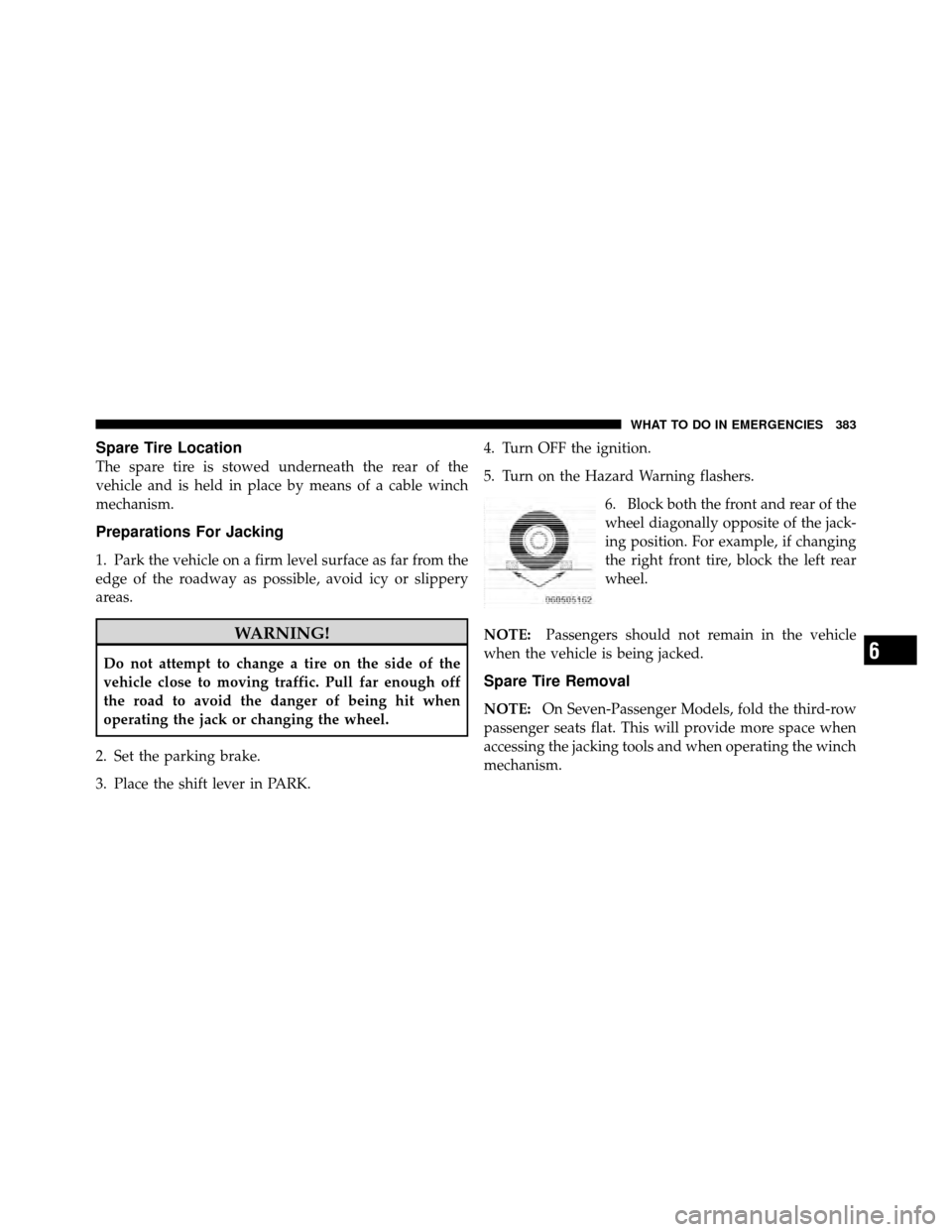Page 332 of 512
Tire Loading and Tire Pressure
Tire Placard Location
NOTE:The proper cold tire inflation pressure is listed
on the driver’s side B-Pillar.
Tire and Loading Information Placard
This placard tells you important information about the:
1) number of people that can be carried in the vehicle
2) total weight your vehicle can carry
3) tire size designed for your vehicle
4) cold tire inflation pressures for the front, rear, and
spare tires.
Tire Placard Location
Tire and Loading Information Placard
5
STARTING AND OPERATING 331
Page 380 of 512
WHAT TO DO IN EMERGENCIES
CONTENTS
�Hazard Warning Flasher ................ 380
� If Your Engine Overheats ................ 380
� Jacking And Tire Changing ............... 381
▫ Jack Location ....................... 382
▫ Spare Tire Location ................... 383
▫ Preparations For Jacking ............... 383
▫ Spare Tire Removal ................... 383
▫ Spare Tire Stowage ................... 385
▫ Jacking Instructions ................... 387
� Jump-Starting ........................ 392 ▫
Preparations For Jump-Start ............. 393
▫ Jump-Starting Procedure ............... 395
� Freeing A Stuck Vehicle ................. 396
� Towing A Disabled Vehicle ............... 398
▫ Without The Ignition Key .............. 398
▫ Towing This Vehicle Behind Another Vehicle
(Flat Towing With The Key In The Ignition
And All Four Wheels On The Ground) ..... 398
▫ Towing This Vehicle Behind Another Vehicle
With A Tow Dolly .................... 400
6
Page 383 of 512
WARNING! (Continued)
•Getting under a jacked-up vehicle is dangerous.
The vehicle could slip off the jack and fall on you.
You could be crushed. Never get any part of your
body under a vehicle that is on a jack. Never start
or run the engine while the vehicle is on a jack. If
you need to get under a raised vehicle, take it to a
service center where it can be raised on a lift.
•The jack is designed to use as a tool for changing
tires only. The jack should not be used to lift the
vehicle for service purposes. The vehicle should
be jacked on a firm level surface only. Avoid ice or
slippery areas.
•A loose tire or jack thrown forward in a collision
or hard stop could endanger the occupants of the
vehicle. Always stow the jack parts and the spare
tire in the places provided.
Jack Location
The jack and jack-handle are stowed underneath a cover
in the rear storage bin in the cargo area.
Jack Storage Location
382 WHAT TO DO IN EMERGENCIES
Page 384 of 512

Spare Tire Location
The spare tire is stowed underneath the rear of the
vehicle and is held in place by means of a cable winch
mechanism.
Preparations For Jacking
1. Park the vehicle on a firm level surface as far from the
edge of the roadway as possible, avoid icy or slippery
areas.
WARNING!
Do not attempt to change a tire on the side of the
vehicle close to moving traffic. Pull far enough off
the road to avoid the danger of being hit when
operating the jack or changing the wheel.
2. Set the parking brake.
3. Place the shift lever in PARK. 4. Turn OFF the ignition.
5. Turn on the Hazard Warning flashers.
6. Block both the front and rear of the
wheel diagonally opposite of the jack-
ing position. For example, if changing
the right front tire, block the left rear
wheel.
NOTE: Passengers should not remain in the vehicle
when the vehicle is being jacked.
Spare Tire Removal
NOTE: On Seven-Passenger Models, fold the third-row
passenger seats flat. This will provide more space when
accessing the jacking tools and when operating the winch
mechanism.
6
WHAT TO DO IN EMERGENCIES 383
Page 390 of 512
4. Raise the vehicle by turning the jack screw clockwise
with the jack handle. Raise the vehicle until the tire just
clears the road surface and enough clearance is obtained
to install the spare tire. Minimum tire lift provides
maximum stability.
Front Jacking LocationRear Jacking Location6
WHAT TO DO IN EMERGENCIES 389
Page 392 of 512

WARNING!
To avoid the risk of forcing the vehicle off the jack,
do not tighten the wheel nuts fully until the vehicle
has been lowered. Failure to follow this warning may
result in personal injury or death.
8. Lower the vehicle by turning the jack screw counter-
clockwise with the jack handle.
9. Finish tightening the wheel nuts. Push down on the
wrench while tightening for increased leverage. Alternate
wheel nuts until each nut has been tightened twice. The
correct wheel nut tightness is 95 ft lbs (130 N·m). If in
doubt about the correct tightness, have them checked
with a torque wrench by your authorized dealer or at a
service station.
10. Lower the jack to its fully closed position.
WARNING!
A loose tire or jack, thrown forward in a collision or
hard stop could endanger the occupants of the ve-
hicle. Always stow the jack parts and the spare tire in
the places provided. Have the deflated (flat) tire
repaired or replaced immediately.
11. Place the deflated (flat) tire in the cargo area. Do not
stow the deflated tire in the spare tire stowage location.
Have the deflated (flat) tire repaired or replaced as soon
as possible.
12. To stow the winch cable and retainer, fit the as-
sembled jack-handle over the winch drive nut. Rotate the
jack-handle assembly clockwise until you hear the winch
mechanism click three times. It cannot be over tightened.
13. Stow the jack-handle and jack.
6
WHAT TO DO IN EMERGENCIES 391